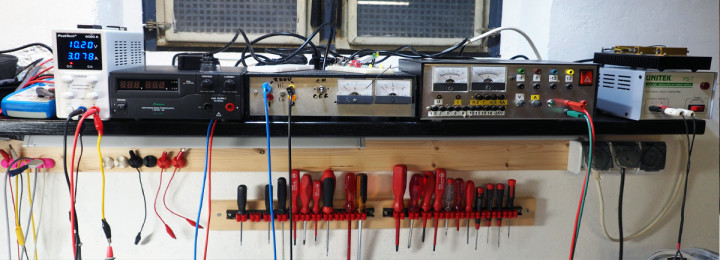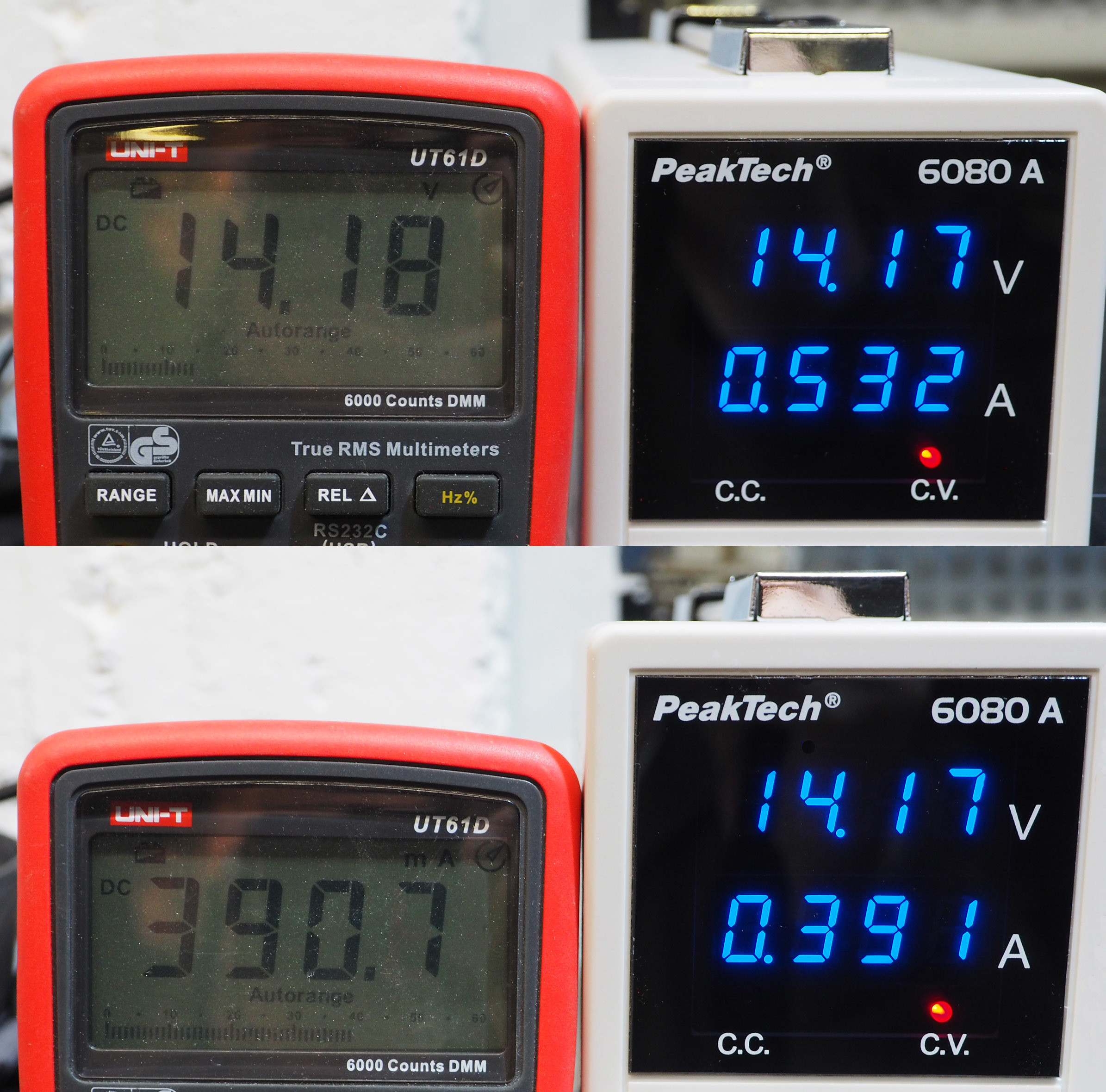Review: The PeakTech 6080 A Lab Power Supply
on
It’s well known that electronics engineers never have enough power supplies. I’m no exception to this rule, as you can see from a photo of the home lab in my basement. It all looks a bit squashed up but I’m sure I could make room for just one more… The small PeakTech 6080 A lab power supply offers power and accuracy for a very reasonable price.

Actually, the home lab is already quite well equipped with power supplies. A 12 V 9 A unit (far right) is ideal to power small low-voltage drilling/grinding machines such as a Dremel or Proxxon etc. You can also see the homemade Elektor Precision Power Supply [1] from 1980! 40 years old and still accurate to 0.1%, good design is the key. Next in line is a relatively high-impedance mains voltage source with safety insulation and a load capacity of around 60 W, it’s not beautiful, but it’s practical and saves lives.
The digital lab power supply delivers a lot of power with a maximum of 60 V at 8 A — this one is obviously not homemade! Now the PeakTech 6080 A has been added to the lineup, it only delivers 3 A at 15 V max, but stands out because of its other features.
Unboxing
The PeakTech 6080 A power supply did not reach me via the normal route that other parcels have taken when they arrive at my door. This time I got a call from a neighbour who lives a few blocks away. He said his parents had seen some packages fall from a passing mail van carrying parcels and my name and address was on one of them. It was Christmas Eve so suspicious of a prank I asked if it was gift wrapped and maybe, was the van being pulled along by… reindeer? He remained serious so I thought it would be best to go and investigate. Sure enough it turned out to be the PT 6080 A power supply unit I had recently ordered. The package was a bit scuffed but not badly damaged.
You may well be wondering the significance of this anecdote: In fact it turned out to be a good drop-test for the power supply, the packaging with its internal foam cushions (Figure 1) did an admirable job of protecting the unit. It survived unscathed and is fully functional.

The unit is 80 x 160 x 225 mm (W x H x D) and its layout is more ‘portrait’ than ‘landscape’ (Figure 2), which takes up less bench space. The thick, heavy heat sink on the back looks well proportioned to keep the power components cool. It is the first indication that this power supply unit is designed using more traditional, linear technology. This type of supply needs to dissipate high levels of power when delivering high current at low output voltages. The second indication of the chosen technology is the unit’s weight: 2 kg is relatively heavy for a 45-W power supply. This indicates there is an iron or ferrite-cored transformer inside running at mains frequency. Switched-mode supplies will use smaller, lighter transformers switching at a much higher frequency.

The lab power supply has an output voltage range adjustable from 0 to 15 V via its two safety 4-mm banana sockets on the front panel which accept shrouded or standard banana plugs. Output current limit can be set from 0 to 3 A using the ‘A’ coarse and fine adjustment pots. Output voltage can be set similarly using the ‘V’ coarse and fine pots. Two four-digit displays show both the output voltage and current level. Two LEDs labelled ‘C.C.’ and ‘C.V.’ indicate whether the unit is operating in constant current or constant voltage mode. Figure 2 shows the C.V. LED lit. When current limiting is active the C.C. LED will be lit instead.
Precision on display
What really interests me with regard to power supplies is the accuracy of the displayed voltage and current levels. I also have a digital power supply unit, where the voltage and current are set digitally using two rotary encoders. This switch between coarse and fine adjustment (in a ratio of 1:10) can be toggled by pressing the knob. Budget priced digital power supplies usually only show the value of what has been setup, not what is actually coming out of the sockets. As a result, there are always small discrepancies in the range of 100 mV or a few tens of milliamps between the displayed value and the actual value. Cheaper digital power supplies often cut costs by omitting the digital voltmeter chip thereby making the displayed values less representative.
The PT 6080 A is different. Instead of encoders, normal potentiometers are used here. The ‘gear ratio’ from coarse to fine adjustment is about 1:7. For me, the analogue setting adjustments took some getting used to. Unlike digital power supplies, you do not immediately see what you are setting. The applied voltage and current flow are measured digitally and average A/D converter chips can manage about three or four measurements per second so there is always a slight delay between the pot movement and the displayed values. I wouldn’t say this is bad, just different from the digital lab power supply I’m used to.
Figure 3 shows an impressive aspect of this power supply: The displayed values are almost identical to those of shown on my multimeter. There is a discrepancy of 10 mV = 0.07 % for the voltage and 0.3 mA = 0.08 % for the current (the deviation is similar at 3 A). This is surprising, I calibrated the multimeter against a 0.1 % accurate reference voltage source before I started measuring. The PT 6080 A is therefore much more precise than the manufacturer's specification of 0.5 % ±5 digits and you can have confidence in the displayed readings. I certainly didn’t expect that!


Noisy or quiet?
The next important aspect is the electrical ‘cleanliness’ of the output voltage under load. A low-power linear lab PSU would not be chosen to primarily power digital electronic circuits. It is more suited as a power source for analogue, audio frequency applications or RF circuits. For these applications it is important to provide a supply free from noise spikes and interference. Except for very expensive laboratory equipment, the output voltages supplied by digital lab PSUs are almost always contaminated with interference and noise signals related to the switching frequencies (and harmonics thereof) used by the switched-mode controller. PSUs based on linear regulators should fare better in this respect, is that true of the PT 6080 A?
The manufacturer states that the residual ripple of the voltage is 0.5 mVrms. Figure 5 shows four screenshots of output voltage waveforms under different load conditions. The sensitivity (2 mV/graduation) and time base (10 ms/graduation) are the same for all of the images. Noise and hum in CV mode are within the specified range both under no load (a) and loaded (b) output conditions.

The output voltage is not quite as good when in CC mode. Here the ripple is around 2 mVeff regardless of the load. The clearly visible low-frequency 128 Hz (c) or 171 Hz (d) fundamental is not a harmonic of the mains frequency so is not likely to be mains hum. This noise level is however still good and since analogue circuits will almost always be powered in CV mode, the slightly increased noise level in CC mode can be ignored. Apart from low electrical noise the design is fanless so no audible noise is generated.
Under the covers
To check out the build quality I removed six screws holding the sheet metal cover on and took a look inside (Figure 6).

The heavy toroidal transformer takes up a lot of the internal volume. It uses a tapped primary winding so it can run on 230 V or 115 V mains. A 30-V winding with a centre tap supplies the front control/display board (C). On the back is the circuit board with a bridge rectifier made from four 5-A diodes and a 4,700 µF/50 V electrolytic capacitor to reduce the ripple. A power transistor is mounted on the back heatsink area. The small black box to the right of the diodes is a relay, which can be heard switching when the output voltage is adjusted around 7.5 V. Below this threshold, the relay switches a transformer secondary winding tap of 12.5 V to the rectifier, above this threshold it switches to the 21.5-V tap. This mechanism reduces the power dissipated in the output transistor when the PSU is operated at high current with a low voltage output setting.
To sum up
By choosing the PeakTech 6080 A (available from the Elektor Store for less than €60) you will be getting a good quality, low noise power supply with digital displays showing impressively accurate output voltage and current readings. A note about the unit calibration is included with the supply but I have more faith in my own measurements I carried out. The electronic components and PCB are of good quality and the unit layout is well designed. The output voltage has no measurable mains hum and is well regulated, showing very little drop under load. The output voltage noise level in CV mode is good and the power supply does not get particularly hot in use, even under high, continuous load conditions. This is mostly due to the low-voltage switchover by the relay, which is a feature not often seen in linear bench power supply units in this price bracket. The unit is also rated as short-circuit proof.
All in all I was impressed by this small lab power supply and would give it a ‘recommended’ rating.



Discussion (2 comments)
Andrew Stanworth 5 years ago
Dr. Thomas Scherer 5 years ago
2. The noise is just noise - statistical noise from the components. Probably from the opamps. With a leven of 0.5 mVrms it seems good to me. There seem to be no capacitor at the ouput, which makes regulation fast but doesn't prevent higher frequency noise. A solution for less noise would be to add an output filter or just a capacitor of around 10 µF / 25 V (parallel to the output).